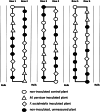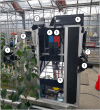Hyperspectral imaging for pest symptom detection in bell pepper
- PMID: 39358772
- PMCID: PMC11447932
- DOI: 10.1186/s13007-024-01273-5
Hyperspectral imaging for pest symptom detection in bell pepper
Abstract
Background: The automation of pest monitoring is highly important for enhancing integrated pest management in practice. In this context, advanced technologies are becoming increasingly explored. Hyperspectral imaging (HSI) is a technique that has been used frequently in recent years in the context of natural science, and the successful detection of several fungal diseases and some pests has been reported. Various automated measures and image analysis methods offer great potential for enhancing monitoring in practice.
Results: In this study, the use of hyperspectral imaging over a wide spectrum from 400 to 2500 nm is investigated for noninvasive identification and the distinction of healthy plants and plants infested with Myzus persicae (Sulzer) and Frankliniella occidentalis (Pergande) on bell peppers. Pest infestations were carried out in netted areas, and images of single plants and dissected leaves were used to train the decision algorithm. Additionally, a specially modified spraying robot was converted into an autonomous platform used to carry the hyperspectral imaging system to take images under greenhouse conditions. The algorithm was developed via the XGBoost framework with gradient-boosted trees. Signals from specific wavelengths were found to be associated with the damage patterns of different insects. Under confined conditions, M. persicae and F. occidentalis infestations were distinguished from each other and from the uninfested control for single leaves. Differentiation was still possible when small whole plants were used. However, application under greenhouse conditions did not result in a good fit compared to the results of manual monitoring.
Conclusion: Hyperspectral images can be used to distinguish sucking pests on bell peppers on the basis of single leaves and intact potted bell pepper plants under controlled conditions. Wavelength reduction methods offer options for multispectral camera usage in high-grown vegetable greenhouses. The application of automated platforms similar to the one tested in this study could be possible, but for successful pest detection under greenhouse conditions, algorithms should be further developed fully considering real-world conditions.
Keywords: Automated; Monitoring; Noninvasive; Pest detection; Robot.
© 2024. The Author(s).
Conflict of interest statement
The authors declare no competing interests.
Figures






References
-
- Stenberg JA. A conceptual Framework for Integrated Pest Management. Trends Plant Sci. 2017;22:759–69. 10.1016/j.tplants.2017.06.010. - PubMed
-
- Mahlein A-K, Steiner U, Dehne H-W, Oerke E-C. Spectral signatures of sugar beet leaves for the detection and differentiation of diseases. Precision Agric. 2010;11:413–31. 10.1007/s11119-010-9180-7.
-
- Ahmad MN, Shariff ARM, Moslim R. Monitoring insect pest infestation via different spectroscopic techniques. Appl Spectrosc Rev. 2018;53:836–53. 10.1080/05704928.2018.1445094.
LinkOut - more resources
Full Text Sources

